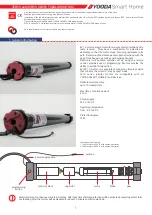
16
www.MarinePowerUSA.com
7.
Precautions
Oil Level
Check the oil level before each engine start up and every eight
(8) hours of continuous operation. It should be understood that
internal combustion engines will use a certain amount of oil
during operation as a cooling and lubricating agent (especially
during break-in period). Oil consumption should decrease after
approximately 100 hours of operation.
IMPORTANT:
The space between the “FULL” and “ADD” marks
on the dipstick represent one quart. It is not necessary to add oil
unless the level is at or below the “ADD” mark.
Engine dipstick level may change due to the angle of
installation. Ensure that “high” oil level is properly marked
accordingly.
When adding crankcase oil, DO NOT OVERFILL.
If crankcase is overfilled, it will cause foaming or aeration of
oil in the oil pan. This will effect oil pressure which may result
in severe internal engine damage.
Hydrolock
Hydrolock describes a condition in which water enters the cylinder
of an engine. Water is not compressible and can cause catastroph-
ic damage. Do not try to start an engine that shows sign of having
water in the cylinders. Beware of these situations:
1. Following Wakes: Sudden slow-downs may cause the boat
wake to flow over the transom of your boat.
2. Engine Shutdown: Sudden engine shutdown while the boat
is moving may force water into the exhaust system.
3. Improper Installation: Refer to Section 13: Exhaust Piping.
An exhaust system without flappers and the specified incline
increases the likelihood of water entering the engine.
4. Improper Hoisting: Operators are sometimes tempted to
reduce hoisting time for propeller changes by hoisting only
the boat stern. Such hoisting can cause residual water in the
exhaust system to enter engine cylinders. Water entering
engine cylinders will cause the engine to lock because water
does not compress.
5. Poor engine cover design: Engines are supposed to be pro-
tected from top side water. If the engine hatch (cover) allows
water to spill on to the top of the engine, water may enter
the cylinders through the flame arrestor.
6. Belt Slinging: Too much water in the bilge of a boat will
sometimes be picked up by the crankshaft pulley and car-
ried into the flame arrestor during a hard acceleration
maneuverer.
To remove water from engine cylinders, take the following steps:
1. Remove all spark plugs.
2. Remove coil wire.
3. Crank engine for 15 seconds.
4. If there are any abnormal sounds STOP ENGINE immediate-
ly and contact your Marine Power dealer.
5. Change engine oil and filters.
6. Replace spark plugs and reattach coil wire.
7. Start engine. If there are any abnormal sounds STOP
ENGINE immediately and contact your Marine Power dealer.
Содержание 5.3 GEN V DI
Страница 15: ...13 www MarinePowerUSA com 6 SSVEC Fuse and Relay Enclosure ...
Страница 16: ...14 www MarinePowerUSA com 6 SSVEC Fuse and Relay Enclosure ...
Страница 17: ...15 www MarinePowerUSA com 6 SSVEC Fuse and Relay Enclosure ...
Страница 48: ...46 www MarinePowerUSA com 13 Installation Instructions Adapter Harness for Digital Gauges Harness M6 M7 472908 ...
Страница 55: ...53 www MarinePowerUSA com Service Log Date Service Maintenance Performed Performed By Operating Hours ...
















































